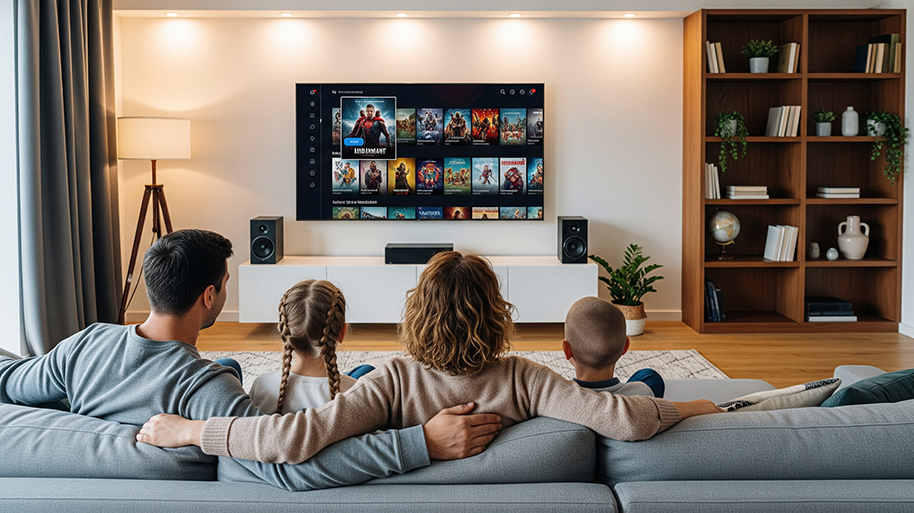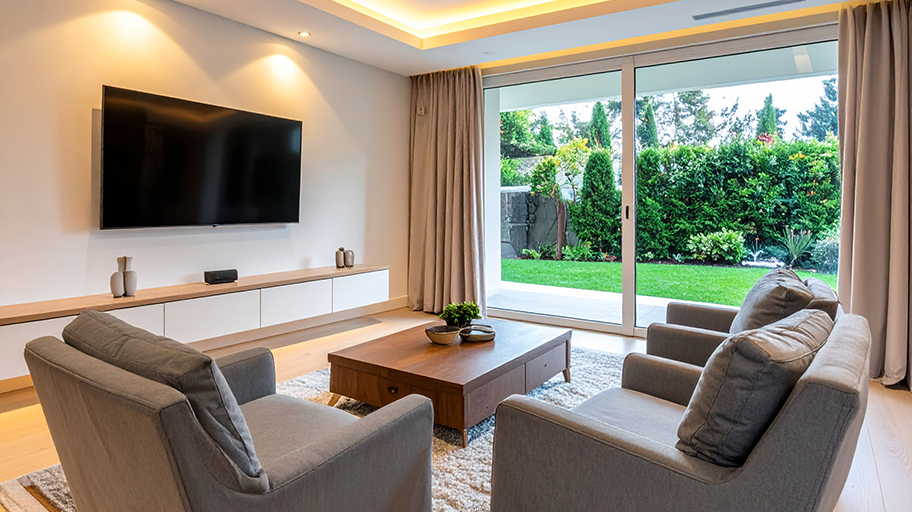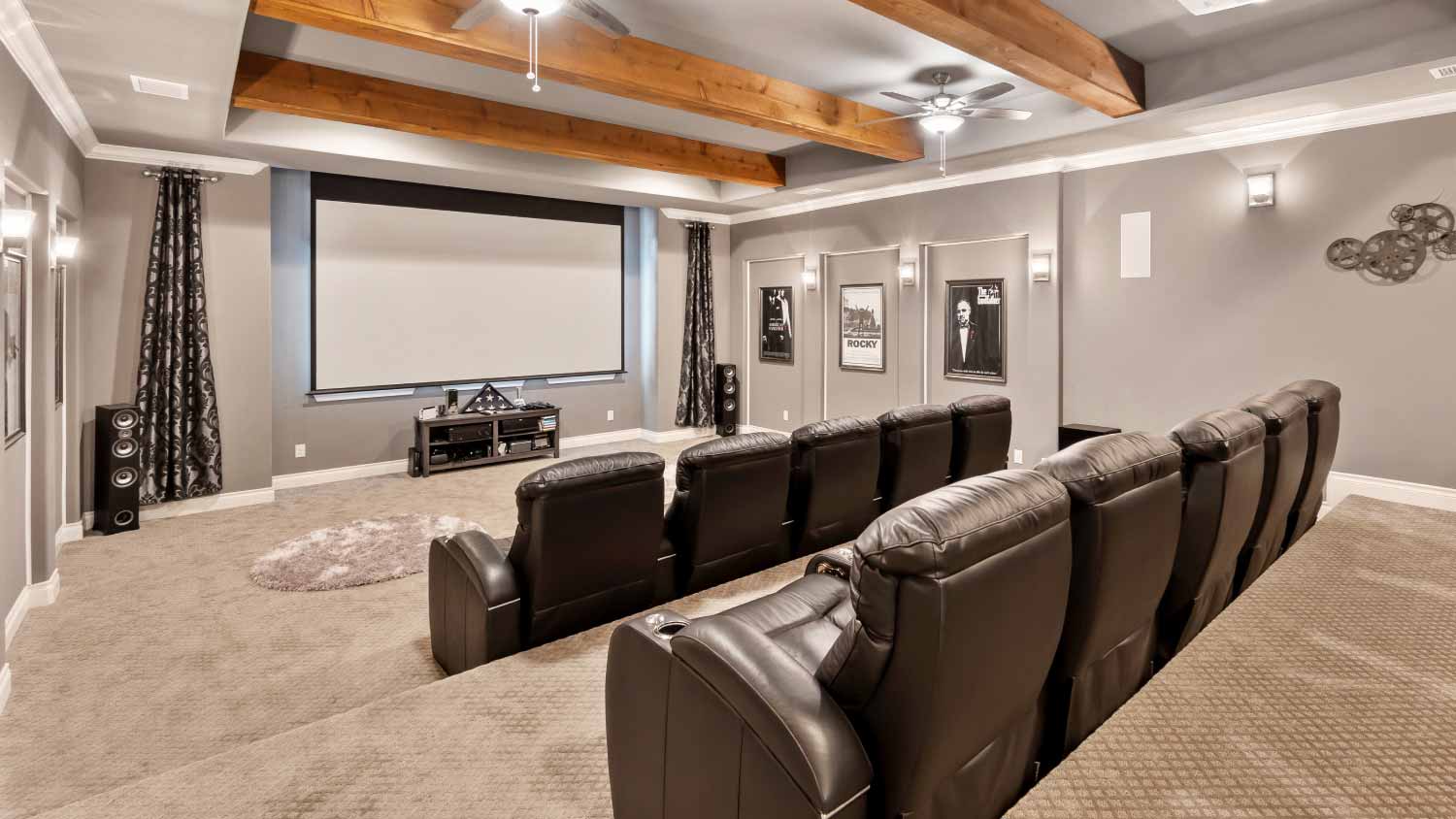
Find out what impacts TV repair cost. Learn average prices, key cost factors, and how to save when repairing your TV.
Home theater wiring costs average $1,400, with most homeowners paying between $1,000 and $2,500. Your price depends on the room size, wiring type, and the complexity of the installation.


Installing home theater wiring involves running cables for audio, video, and control systems to create an immersive entertainment space.
Key cost factors include the size of your room, the number of speakers, cable quality, and labor for routing wires through walls or ceilings.
Upgrading your wiring can increase home value and appeal to buyers who want modern, entertainment-ready spaces.
Completing this project improves sound and video performance, reduces clutter, and ensures your system is safe and up to code.
For most homes, expect labor costs to range from $50 to $120 per hour, depending on the complexity and region.
This article was created using automation technology and thoroughly fact-checked and edited by an Angi Editor in accordance with our AI policy.
Home theater wiring costs range from $700 to $2,900, with an average of $1,400 for a standard installation. Costs vary based on room size, number of components, and whether you’re wiring a new or existing space. Expect to pay $2 to $5 per linear foot for most home theater wiring projects.
Upgrading your home theater wiring ensures reliable performance, supports advanced audio-visual systems, and can add value to your home. In this guide, we’ll break down the costs, main factors, and smart tips for planning your project.
The size of your home theater and the scope of your setup are major drivers of total wiring costs. A larger room requires more cable to reach every speaker, subwoofer, and component, whereas a simple setup with fewer speakers costs significantly less than a multi-zone system.
The number of speakers and zones adds complexity, as each requires dedicated wiring runs. For example, a small room with a basic 5.1 surround system will use less wiring than a large space with Dolby Atmos and multiple audio zones. Multi-room or whole-home audio/video wiring projects increase both material and labor costs, as cables must be routed through walls, floors, or ceilings over greater distances.
| Room Size | Number of Speakers | Average Lin. Ft. of Wiring | Average Cost Range |
|---|---|---|---|
| Small | 5–6 | 80–120 | $700–$1,000 |
| Medium | 7–9 | 120–200 | $1,000–$1,800 |
| Large | 9–12+ | 200–350 | $1,800–$2,500+ |
The type of wiring you select greatly impacts both cost and performance. Home theater systems often require several cable types: speaker wire for audio, HDMI for video, coaxial for cable or satellite, Ethernet for network connections, optical cables for digital audio, and control cables for automation.
In-wall rated cables cost more than standard versions but are necessary for safety and code compliance. Quality tiers range from basic to premium; higher-grade cables offer improved shielding and signal integrity, which can be important for high-end systems or long runs. Specialty wiring, such as for Dolby Atmos or smart home integration, adds cost due to increased requirements and technical demands.
| Wiring Type | Description | Cost per Lin. Ft. | Pros | Cons |
|---|---|---|---|---|
| Speaker wire | Delivers audio signals to speakers | $0.30–$1.00 | Essential for surround sound | Can be bulky in-wall |
| HDMI | Carries high-definition video/audio | $1.00–$4.00 | Single cable for AV, high quality | Limited length for best signal |
| Coaxial | For cable/satellite and some subwoofers | $0.50–$1.50 | Versatile, durable | Bulky, less flexible |
| Ethernet | Network/data connections | $0.20–$1.00 | Needed for streaming/smart systems | May require special jacks |
| Optical (Toslink) | Digital audio transmission | $1.00–$2.50 | No interference, high fidelity | Fragile, limited length |
| Control cables | Automation, IR, or remote control signals | $0.30–$1.50 | Enables smart features | Adds to wiring complexity |
Choosing the right mix of cables ensures your system performs well and meets future needs.
Where you live and where the wiring is installed within your home can make a noticeable difference in total cost. Labor and materials tend to cost more in urban or high-demand areas, while rural regions may offer lower rates but less access to specialized installers. Installing wiring in finished spaces, basements, attics, or exterior walls may require extra time and specialized tools, especially in multi-story homes.
| Region/Location | Average Cost | Cost Range | Notes |
|---|---|---|---|
| Basement | $1,000 | $700–$1,800 | Easier access, lower labor costs |
| Main floor/finished | $1,400 | $1,000–$2,500 | More challenging, higher labor costs |
Several individual elements make up your total home theater wiring cost, with labor and materials being the largest portions.
Licensed electricians, AV installers, or general contractors often handle professional installation. Hourly rates for local home theater pros range from $50 to $120, with some specialists charging a minimum service fee.
New construction jobs are less costly since walls are open, while retrofits in finished spaces require more labor for fishing wires, patching, and cleanup. Regional wage differences also play a role, and more complex systems with many speakers or hidden wiring increase labor hours.
Depending on your municipality, permits may be required for home theater wiring, especially when new circuits, outlets, or in-wall wiring are involved. Permit costs vary, often ranging from $50 to $200, with possible inspection fees. Ensuring code compliance is critical for safety and resale value. Skipping permits can lead to fines, failed inspections, or insurance issues.
Enhancements such as wall plates, recessed outlets, and cable management systems improve both function and appearance, but they also add to the total cost. Upgrades such as surge protection, smart home integration, or remote-control wiring require additional materials and labor. Custom features—such as hidden wiring, in-wall speakers, or projector wiring—bring a premium, especially if drywall or ceiling work is required.
Routine inspection and cleaning help ensure long cable life and system performance. High-quality wiring can last decades, but exposure to heat, moisture, or pests may shorten its lifespan. If you notice signal loss or intermittent issues, repairs or replacements may be required, with minor electrical repairs costing $100 to $300.
Project complexity is a key cost driver. Retrofitting existing spaces, working around insulation or obstacles, and routing wiring through multiple stories increases both labor and materials. Site prep, such as moving furniture or cutting drywall, can add time. After installation, you may need to repair or repaint the walls. For custom setups, design, or consultation, fees and code inspections may be necessary.
Deciding whether to tackle wiring yourself or hire a professional has a significant impact on your overall cost, timeline, and final results.
For DIYers, material costs range from $200 to $800, depending on system size and cable quality. Necessary tools include fish tape, wire strippers, wall plates, and testers, which may add $50 to $200 if not already owned.
DIY installation requires a solid understanding of electrical safety, local codes, and AV system design. Expect to invest several days in planning, measuring, running cables, and testing. Mistakes—such as using improper wire types or failing to secure connections—can cause safety hazards or poor performance.
Professional installation includes both labor and materials, with total costs from $700 to $2,500 or more. Pros ensure code compliance, optimal system layout, and clean finishes. Most offer warranties on labor and may provide ongoing support. Hiring a home theater pro reduces the risk of fire hazards, code violations, and system issues, and can save time and stress for homeowners.
Home theater wiring may need repair or replacement due to age, damage, or system upgrades.
Repair is suitable for minor issues, such as signal loss, loose connections, or visible damage in accessible areas. Replacement is best for outdated wiring, code violations, or when upgrading to support new technologies.
If repair costs approach 50% of the replacement cost, or if the wiring is more than 15 to 20 years old, replacement is a better investment. Warranty status and the extent of damage also influence the decision.
| Scenario | Description | Average Cost | Cost Range |
|---|---|---|---|
| Repair | Fixing loose, damaged, or faulty wiring | $150 | $100–$400 |
| Replacement | Full replacement, new wiring for the entire system | $1,200 | $700–$2,500+ |
Investing in professional home theater wiring can increase your home’s value, especially in markets where entertainment spaces are in demand. Buyers appreciate move-in-ready homes with built-in audio-visual features, seeing them as modern, convenient, and luxurious.
Compared to other home upgrades, home theater wiring has a moderate ROI, especially when integrated seamlessly and installed to code. Quality wiring also adds safety, energy efficiency, and universal design benefits, making your home more appealing and functional.
To keep your project costs within budget, consider the following tips:
Obtain multiple quotes from licensed professionals for the best pricing.
Select wiring types and features that align with your needs and budget.
Plan wiring routes in advance to minimize labor and material waste.
Bundle wiring installation with other renovation projects to save on labor.
Consider partial DIY (e.g., pre-wiring or prep work) to reduce costs.
Opt for standard-grade materials where premium is not required.
Schedule installation during off-peak seasons for potential discounts.
Home is the most important place on earth, which is why Angi has helped more than 150 million homeowners transform their houses into homes they adore. To help homeowners with their next project, Angi provides readers with the most accurate cost data and upholds strict editorial standards. We extensively research project costs to develop the pricing data you see, so you can make the best decisions for you and your home. We rely on reputable sources, including the U.S. Bureau of Labor Statistics, academic journals, market studies, and interviews with industry experts—all to ensure our prices reflect real-world projects.
Want to help us improve our cost data? Send us a recent project quote to [email protected]. Quotes and personal information will not be shared publicly.
From average costs to expert advice, get all the answers you need to get your job done.

Find out what impacts TV repair cost. Learn average prices, key cost factors, and how to save when repairing your TV.

Discover the average surround sound installation cost, key price factors, and tips to save. Get expert insights to plan your home audio project.

Explore home theater installation costs. Get detailed breakdowns, cost factors, and expert tips to help you budget and plan your dream home theater.

From a cozy living room to a cinematic experience, knowing what size of TV you need can enhance your space. Use this guide to shop for the perfect TV.

Discover the average home theater repair cost, key price factors, and tips to save. Get transparent estimates and plan your repair with confidence.

If you’re preparing to install a home theater surround sound system, here are the home theater questions you should discuss with your pro.